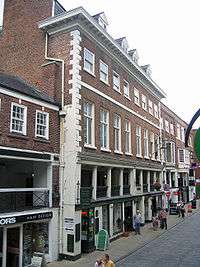Booth Mansion
| Booth Mansion | |
|---|---|
|
Booth Mansion | |
| Location | 28–34 Watergate Street, Chester, Cheshire, England |
| Coordinates | 53°11′24″N 2°53′35″W / 53.19011°N 2.89295°WCoordinates: 53°11′24″N 2°53′35″W / 53.19011°N 2.89295°W |
| OS grid reference | SJ 404 662 |
| Built | 1700 |
| Built for | George Booth |
| Architectural style(s) | Georgian |
Listed Building – Grade I | |
| Official name: Nos.28-34 (even) Street and Nos.28 & 30 Row (Booth Mansion) | |
| Designated | 28 July 1958 |
 Location in Cheshire | |
Booth Mansion is a former town house at 28–34 Watergate Street, Chester, Cheshire, England. It contains a portion of the Chester Rows, is recorded in the National Heritage List for England as a designated Grade I listed building,[1] and is included in the English Heritage Archive.[2] Its frontage was built in 1700 in Georgian style but much medieval material remains behind it.
History
In 1700 George Booth rebuilt two medieval houses as his town house.[3] He built a frontage in Georgian style,[4] but behind this much of the medieval fabric was retained. The frontage was angled into the street so that the house could be seen better from Chester Cross; however as a result of this he was fined £10 for encroaching into the street.[3] In the 1740s and 1750s the building was used as the assembly rooms for the town's social functions.[5] Subsequently it has been used as an auction gallery[1] and, as of 2010, houses a firm of solicitors.[6] Reopened in October 2016 as a gallery, tearoom, deli, chocolatier, gifts and accessories. The top two floors of the building will be renovated and used as micro office space for artists studios and offices for startups, micro businesses operating in the creative industries.
Architecture
At a time when buildings elsewhere in the town had enclosed their portion of the Rows, the architect designing the frontage of Booth Mansion retained its section of the Row.[3] The frontage is built in brick with stone quoins; it has eight bays and two storeys.[7] Behind the frontage is medieval stonework and timber; the roof is of grey slates. At the street (undercroft) level are shop fronts and doorways between nine stone piers. At the Row level, overlooking the street, are three piers and six Tuscan columns. In the storey above the row are eight tall windows, each with four leaded lights, above which is a string course. The top storey has eight six-light sash windows. Above these is a cornice and, from the roof, four gabled dormers with two-pane casement windows protrude.[1]
Interior
In the undercroft is a medieval stone arcade and a wooden joist which has been dated by dendrochronology to 1260–80. At the level of the Row, a 13th-century oak doorway remains from the medieval hall. In the storey above the Row is the 18th-century assembly room which measures 16m by 10m and stretches across the full width of the building. The room is panelled and has a fireplace against the east wall. Elsewhere the medieval details of rooms has been obscured by modern additions.[1]
See also
References
- 1 2 3 4 Historic England, "Numbers 28 and 30 Row, Booth Mansion, 28–34 Street, Chester (1376434)", National Heritage List for England, retrieved 8 April 2012
- ↑ Pastscape: Booth Mansion, Historic England, retrieved 3 August 2009
- 1 2 3 Ward, Simon (2009), Chester: A History, Chichester: Phillimore, pp. 74–75, ISBN 978-1-86077-499-7
- ↑ Morriss, Richard (1993), The Buildings of Chester, Dover: Alan Sutton, p. 97, ISBN 0-7509-0255-8
- ↑ Thacker, A. T.; Lewis, C. P. (eds.) (2005), Leisure and culture: Places of entertainment, A History of the County of Chester: The City of Chester: Culture, Buildings, Institutions, 5,(2), pp. 269–273, retrieved 3 August 2009
- ↑ Oliver & Co Solicitors, Oliver & Co Solicitors, archived from the original on 23 January 2010, retrieved 11 March 2010
- ↑ Hartwell, Clare; Hyde, Matthew; Hubbard, Edward; Pevsner, Nikolaus (2011) [1971], Cheshire, The Buildings of England, New Haven and London: Yale University Press, pp. 264–265, ISBN 978-0-300-17043-6
